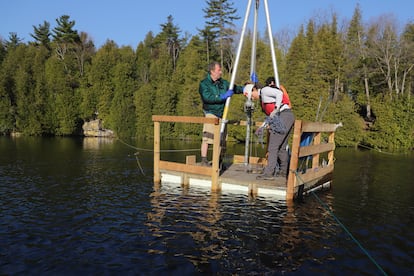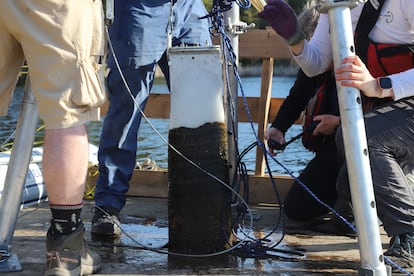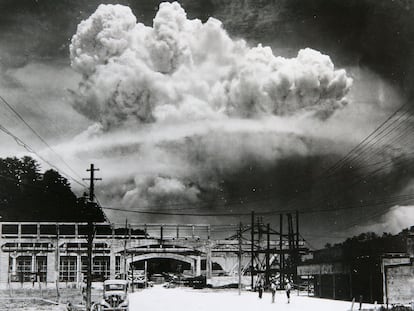A Canadian lake holds evidence that humanity caused a new geological epoch after 1950: The Anthropocene
Crawford Lake hides a history book at its bottom: perfect layers of sediments that show centuries of human impact, year by year

The seemingly tiny Crawford Lake, just outside Toronto, Canada, is an unusual one. The residents of the area usually go there to walk their dogs and eat their famous pancakes with maple syrup, but that is not what makes it special. The lake seems small – barely 820 feet across – but it hides an extraordinary depth of 79 feet. It is meromictic, which means that its surface waters do not mix with those at the bottom, which has remained undisturbed for centuries. Sediments from the atmosphere accumulate each year on the bed, like the layers of a lasagna. Now, an international team of scientists announced Tuesday that Crawford Lake is the place where the beginning of a potential new geological epoch (around 1950), the Anthropocene, is best appreciated.
Geologist Francine McCarthy shows the photo of a sediment sample taken from the depths of the lake. It is a vertical sample, barely 35 inches, but it tells the history of the Crawford since the 13th century, year after year. It is very easy to see the passage of time in it. In the winter the lake freezes and dark organic matter settles on the bottom. In the summer, the calcium and carbonates from the area’s limestone rocks, dissolved in the water, crystallize due to the heat, forming a white layer of calcite on the bed. That succession of light and dark lines is a perfect calendar, an underwater history book that shows how in 1950 human impact began to transform everything. It is the so-called Great Acceleration, the moment in which nuclear bomb tests, the massive burning of coal and oil and the disappearance of species began to leave a very evident imprint on the skin of the planet.
Humanity is officially going through the Holocene, a geological epoch that began more than 10,000 years ago, after the last ice age. However, in 2000, the Dutch chemist Paul Crutzen (winner of the Nobel Prize in Chemistry for shedding light on the destruction of atmospheric ozone) and the American biologist Eugene Stoermer suggested that the impact of human beings on the planet had brought about a new epoch: the Anthropocene. Although the idea caught on, the certifying body, the International Union of Geological Sciences, has yet to make a decision. A team of experts, the Anthropocene Working Group, has been investigating since 2009 whether humanity has indeed entered a new era. In 2016, they declared the Anthropocene a geological reality, and this Tuesday, the group’s leader, British geologist Colin Waters, announced at a conference in Lille, France, that Crawford Lake is the best model for observing the beginning of this disturbing era that is characterized by human pollution.
The scientific community, through the International Commission on Stratigraphy, chooses reference points that mark the beginning of new geological stages. The start of the Holocene is officially represented by an ice core obtained in 2003 almost 5,000 feet deep, in Greenland. This frozen sample, guarded at the University of Copenhagen, in Denmark, reveals a rapid warming of the climate associated with a change in certain chemical elements. The reference points of seven geological stages are located in Spain: in the city of Fuentelsaz, for example, the beginning of the Middle Jurassic, some 175 million years ago, can be appreciated better than anywhere, and the coast of Zumaia (Basque Country) has two official boundaries between stages of the Paleocene. All these points are marked by golden spikes, which are placed in solemn ceremonies.

A dozen places were vying for the golden spike of the Anthropocene, including the remote Sihailongwan Lake, located in the crater of a Chinese volcano, and the sea mud of Japan’s Beppu Bay, both of which made it to the final round of voting. However, “Crawford Lake is where the beginning of the Anthropocene is best recorded today,” says Spanish geologist Alejandro Cearreta, a member of the international working group. “The best indicator is the plutonium-239. All the sediments after 1950 have plutonium, be it the park next to your house or Crawford Lake,” explains Cearreta, professor of paleontology at the University of the Basque Country.
The geological authorities are in no rush to declare the official start of a new epoch. According to Cearreta, the complex protocol can take years. The Anthropocene Working Group will submit its final proposal, including Crawford Lake, in the coming weeks. The Subcommission on Quaternary Stratigraphy will study the conclusions and, if it concurs, will send them to the higher level: the International Commission on Stratigraphy. If 60% or more of its members vote in favor of declaring the beginning of the Anthropocene, the decision will then have to be ratified by the International Union of Geological Sciences. “The process can be interrupted at any moment,” warns Cearreta.
Canadian geologist Francine McCarthy is sure that Crawford Lake will help convince the skeptics. Her team inserts a tool known as “frozen finger” into the bottom, a frozen artifact, filled with liquid nitrogen at almost -200 degrees Celsius (-328 Fahrenheit), to which the sediments adhere. The human influence is evident: layers from the late 13th century already include corn pollen, confirming the presence of indigenous tribes in the area. The thickest white line corresponds to the year 1935, the hottest summer of the so-called Dust Bowl, a period characterized by drought and sandstorms caused by deforestation. And after 1950, the radioactivity of the atomic bombs and the pollutants from the burning of coal and oil can be seen. They are irreversible changes, recognizable everywhere, as defended by the Anthropocene Working Group. “Every time we extract a frozen core from the bottom of this unique lake, it is like attending a birth: they are all beautiful when they first emerge. Knowing that they can reveal so much relevant information is overwhelming,” says McCarthy.
Sign up for our weekly newsletter to get more English-language news coverage from EL PAÍS USA Edition
Tu suscripción se está usando en otro dispositivo
¿Quieres añadir otro usuario a tu suscripción?
Si continúas leyendo en este dispositivo, no se podrá leer en el otro.
FlechaTu suscripción se está usando en otro dispositivo y solo puedes acceder a EL PAÍS desde un dispositivo a la vez.
Si quieres compartir tu cuenta, cambia tu suscripción a la modalidad Premium, así podrás añadir otro usuario. Cada uno accederá con su propia cuenta de email, lo que os permitirá personalizar vuestra experiencia en EL PAÍS.
¿Tienes una suscripción de empresa? Accede aquí para contratar más cuentas.
En el caso de no saber quién está usando tu cuenta, te recomendamos cambiar tu contraseña aquí.
Si decides continuar compartiendo tu cuenta, este mensaje se mostrará en tu dispositivo y en el de la otra persona que está usando tu cuenta de forma indefinida, afectando a tu experiencia de lectura. Puedes consultar aquí los términos y condiciones de la suscripción digital.
More information
Archived In
Últimas noticias
Most viewed
- Reinhard Genzel, Nobel laureate in physics: ‘One-minute videos will never give you the truth’
- Oona Chaplin: ‘I told James Cameron that I was living in a treehouse and starting a permaculture project with a friend’
- Pablo Escobar’s hippos: A serious environmental problem, 40 years on
- Chevy Chase, the beloved comedian who was a monster off camera: ‘Not everyone hated him, just the people who’ve worked with him’
- Why we lost the habit of sleeping in two segments and how that changed our sense of time










































